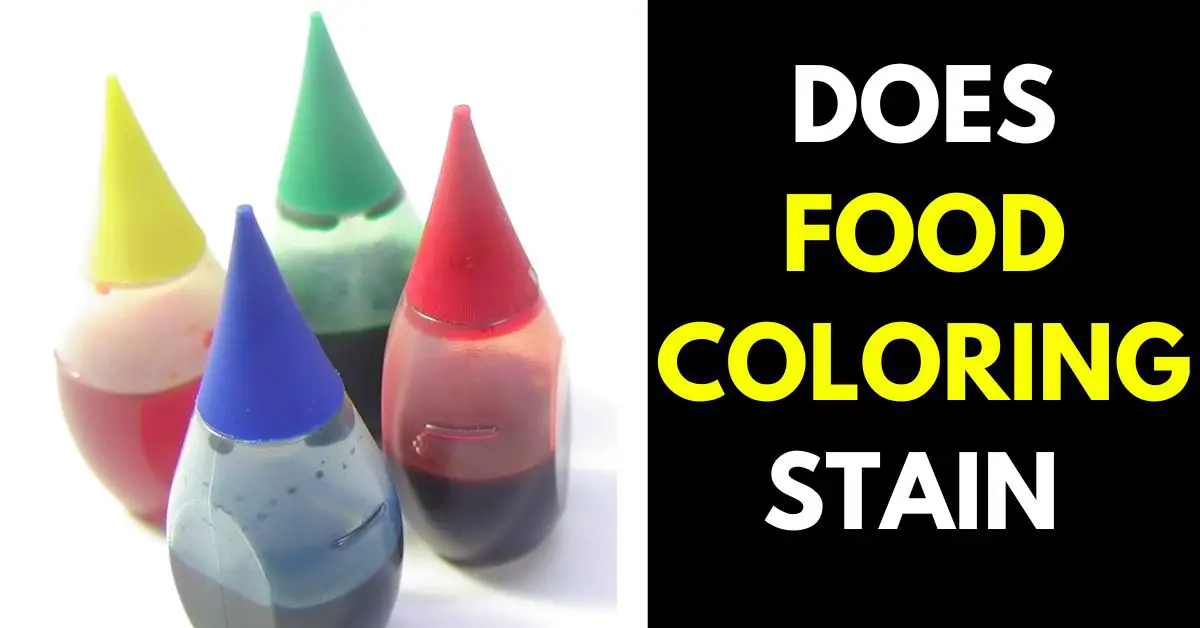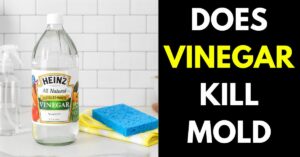
Food coloring is a popular ingredient that adds vibrancy and color to many foods we enjoy, from cakes and candies to drinks and even savory dishes. However, many people have wondered whether or not food coloring stains, and if so, how to remove those stains. Whether you’re a parent concerned about your child’s stained clothes, a baker worried about your kitchen countertops, or simply curious about the science behind food coloring, this blog post will explore the question: Does food coloring stain?
Yes, food coloring can stain certain surfaces such as clothing, countertops, and kitchen utensils if it is not cleaned up promptly or if it is not used in a careful manner. The level of staining depends on various factors, such as the concentration of the food coloring, the type of surface, and the amount of time the coloring remains on the surface.
We’ll examine the different types of food coloring, their ingredients, and their potential for staining, as well as offer tips for removing any stains that do occur. So, let’s dive in and find out whether or not food coloring is a stain culprit or not!
What is Food Coloring
Food coloring, also known as food dye or food pigment, is a substance added to food and beverages to enhance their visual appeal or to make them look more appetizing. Food coloring comes in various colors and can be either natural or synthetic.

Natural food coloring is derived from natural sources such as fruits, vegetables, and spices. For example, beet juice can be used to make red food coloring, while turmeric can be used to create yellow food coloring. These natural sources are often used to create pastel or lighter shades of color.
Synthetic food coloring, on the other hand, is made from chemical compounds and is often more potent and brighter in color than natural food coloring. Synthetic food coloring is commonly used in processed foods and beverages, such as soft drinks, candy, and baked goods, to give them a bright and consistent color.
Food coloring can be found in a variety of forms, including liquids, powders, gels, and pastes. The amount of food coloring used in a product can vary depending on the desired color intensity and the specific food or beverage being colored.
Does Food Coloring Stain
Yes, food coloring can stain surfaces such as fabrics, countertops, and even skin. The potential for staining largely depends on the type of food coloring used, the concentration of the color pigments, and the surface it comes in contact.

Synthetic food coloring, which is often more potent and brighter in color than natural food coloring, is more likely to leave stains. When it comes to surfaces, food coloring can easily stain fabrics, especially lighter-colored ones.
It can also stain surfaces such as countertops and cutting boards, particularly if the surfaces are porous or have cracks or crevices where the color can seep in.
Is Food Coloring Permanent on Clothes?
Whether or not food coloring is permanent on clothes largely depends on the type of fabric and the length of time the stain has been left untreated.
Food coloring can be difficult to remove from clothes, especially if the fabric is porous or the color pigments have had time to set in. Synthetic food coloring, which is often more concentrated and vibrant, is also more likely to leave permanent stains.

If a food coloring stain is left untreated for a long time, it can become more difficult to remove, and the color may become more permanent. Additionally, some fabrics are more prone to staining than others.
Natural fibers such as cotton, wool, and silk may absorb food coloring more readily and be more challenging to clean than synthetic fibers such as polyester or nylon.
Does Food Coloring Stain Come Out?
Yes, food coloring stains can be removed with proper treatment and the right cleaning techniques. The effectiveness of the treatment largely depends on the type of fabric and the length of time the stain has been left untreated.
To remove food coloring stains from fabrics, it’s recommended to act quickly and rinse the stain with cold water as soon as possible. Then, apply a stain remover or laundry detergent directly to the stain and allow it to sit for a few minutes before washing the fabric in cold water.
For more stubborn stains, it may be necessary to repeat the treatment process or soak the fabric in a mixture of laundry detergent and water for several hours before washing. Bleach is generally not recommended for removing food coloring stains, as it can cause discoloration or damage to certain fabrics.
How Do I Get Food Coloring Out of Clothes?
To get food coloring out of clothes, follow these steps:
- Act quickly: Rinse the stained area with cold water as soon as possible. This will help remove as much of the stain as possible before it sets into the fabric.
- Apply a stain remover: Apply a stain remover or laundry detergent directly to the stain, and rub it gently into the fabric. You can use a commercial stain remover or make a DIY solution by mixing equal parts water and white vinegar or water and baking soda.
- Soak the garment: Soak the garment in cold water for at least 30 minutes or up to several hours.
- Wash the garment: Wash the garment in cold water with a laundry detergent that contains enzymes, as this can help break down the stain. Avoid using hot water or a dryer, as this can set the stain further into the fabric.
- Repeat the process: If the stain is still visible after the first wash, repeat the process until the stain is completely removed.
Note: Always check the care label on your garment before attempting to remove a stain, as some fabrics may require special care or cannot be treated with certain cleaning agents.
How Do You Keep Food Coloring from Staining?
To prevent food coloring from staining surfaces or fabrics, there are several steps you can take:
- Wear protective clothing: Wear protective clothing such as an apron or old clothes when working with food coloring.
- Use a drop cloth or plastic sheet: Cover the work surface with a drop cloth or plastic sheet to prevent any spills or drips from staining the surface.
- Use a non-porous surface: Use a non-porous surface such as a glass or plastic cutting board when working with food coloring, as this will make it easier to clean up any spills or stains.
- Clean up spills immediately: If a spill occurs, clean it up immediately with a damp cloth and a mild detergent or stain remover.
- Dilute the food coloring: Dilute the food coloring with water to reduce the concentration of the color pigments. This can help prevent the color from staining surfaces or fabrics.
- Use natural food coloring: Consider using natural food coloring made from fruits, vegetables, or herbs instead of synthetic food coloring, as natural food coloring is generally less likely to stain surfaces or fabrics.
By taking these steps, you can help prevent food coloring from staining surfaces or fabrics and make clean-up easier in case of any spills or drips.
What Food Coloring Does Not Stain?
While all food colorings have the potential to stain surfaces or fabrics, some types of food coloring are less likely to leave a permanent stain than others. Here are some food colorings that are less likely to stain:
- Natural food coloring: Natural food coloring made from fruits, vegetables, or herbs is generally less likely to stain than synthetic food coloring. Some examples of natural food coloring include beet powder, turmeric, and spirulina.
- Gel food coloring: Gel food coloring is thicker and more concentrated than liquid food coloring, so it’s less likely to drip or spread onto surfaces. It also tends to be more colorfast and less likely to bleed or fade over time.
- Powdered food coloring: Powdered food coloring is also less likely to drip or spread onto surfaces, and it can be easier to control the intensity of the color. However, it can be more difficult to dissolve and incorporate into certain types of foods.
Does Food Coloring Stain Related Questions
Does Food Coloring Stain Skin
Food coloring can stain skin, especially if it is left on for an extended period of time or if it is applied to sensitive areas like the face or hands. However, most food coloring stains on skin are temporary and will fade within a few days.
To minimize the risk of staining your skin with food coloring, you can take the following precautions:
- Wear gloves: Consider wearing gloves when working with food coloring to protect your hands from stains.
- Apply a barrier: Apply a thin layer of petroleum jelly or lotion to the skin around the area you will be working with food coloring. This can help prevent the food coloring from staining the skin.
- Wash your skin immediately
Does Food Coloring Stain Clothes
Yes, food coloring can stain clothes, especially if it is not cleaned up promptly. The pigments in food coloring can penetrate fabric fibers and leave a lasting stain.
However, the extent of the staining can depend on various factors such as the type and color of the fabric, the concentration of the food coloring, and how long it remains on the fabric. Darker colors like red and blue food coloring are more likely to leave a stain than lighter colors like yellow or green.
Does Food Coloring Stain Teeth
Yes, food coloring can stain teeth, especially if it is consumed in large amounts or over a prolonged period of time. Some food colorings such as red and blue can adhere to the tooth enamel and cause discoloration.
However, most food coloring stains on teeth are temporary and can be removed with regular brushing and dental cleaning. To prevent food coloring from staining your teeth, you can limit your consumption of foods and drinks that contain large amounts of food coloring.
You can also rinse your mouth with water after consuming food or drinks with food coloring to help minimize the staining effect.
Additionally, maintaining good oral hygiene practices such as regular brushing and flossing can help prevent food coloring from adhering to the tooth surface.
Does Food Coloring Stain Concrete
Yes, food coloring can stain concrete. Food coloring contains dyes that can penetrate into the porous surface of concrete and leave a stain. The severity of the stain depends on factors such as the concentration of the food coloring, the length of time the food coloring is in contact with the concrete, and the porosity of the concrete surface.
Does Food Coloring Stained Glass
Food coloring can be used to stain glass in a process called “stained glass painting”. When using food coloring for this purpose, the color is mixed with a medium, such as white glue or clear nail polish, and applied to the glass surface using a brush or other applicator. The color can be blended and layered to create the desired effect.
Does Food Coloring Stain Porcelain
Yes, food coloring can stain porcelain surfaces. Porcelain is a hard, dense material that is resistant to most stains, but it can still be stained by substances that are highly pigmented, acidic, or alkaline. Food coloring contains dyes that can penetrate into the porous surface of porcelain, especially if the porcelain is unglazed or has cracks or chips on the surface.
Does Food Coloring Stain Bathtub
Food coloring can stain a bathtub. Most bathtubs are made of materials like porcelain, enamel, fiberglass, or acrylic, all of which can be porous to some extent. If food coloring is left in contact with the surface of a bathtub for a prolonged period, it can penetrate into the pores of the surface and leave a stain.
To prevent staining, it’s best to clean up any food coloring spills in the bathtub as soon as possible. Use a mild cleaning solution and a soft cloth or sponge to wipe the affected area clean. Avoid using abrasive cleaning agents or scrubbers, as these can damage the surface of the bathtub and make it more prone to staining.
Does Food Coloring Stain Ceramic
Food coloring will stain ceramic, especially if it is left on the surface for an extended period of time. Ceramic is porous, and some food colorings contain strong pigments that can seep into the surface of the ceramic and become difficult to remove.
The extent of staining can also depend on the type of ceramic and the finish. Unglazed or porous ceramic surfaces are more likely to absorb the color and become stained, while glazed or coated ceramic surfaces may be more resistant to staining.
Does Green Food Coloring Stain Toilets
Green food coloring can stain toilets, especially if it is left on the surface for an extended period of time. Toilets are made of porcelain, which is a type of ceramic, and like ceramic, it can be porous and absorb pigments.
Does Black Food Coloring Stain Teeth
Black food coloring will stain teeth, especially if it is used frequently or in large amounts. Food colorings contain pigments that can stick to the surface of teeth and cause discoloration over time.
Does Red Food Coloring Stain Clothes
Red food coloring can potentially stain clothes, especially if it is not cleaned up immediately. Food coloring contains pigments that can be difficult to remove from fabric once they have been set.
Does Gel Food Coloring Stain Skin
Gel food coloring can potentially stain skin, especially if it is not washed off immediately. Food coloring contains pigments that can penetrate the skin and cause discoloration.
Does Shaving Cream and Food Coloring Stain
Shaving cream and food coloring can potentially stain certain surfaces, especially if they are not cleaned up promptly.
Does Red Food Coloring Stain Skin
Yes, red food coloring can stain skin, especially if it is not washed off immediately. Food coloring contains pigments that can penetrate the skin and cause discoloration.
The extent of staining can depend on various factors, including the amount of food coloring applied, the duration of exposure, and the individual’s skin type. People with sensitive or dry skin may be more susceptible to staining.
Does Gel Food Coloring Stain
Gel food coloring can potentially stain certain surfaces, especially if it is not cleaned up promptly. The extent of staining can depend on various factors, including the type of surface and the duration of exposure.
Surfaces such as fabric, carpet, or porous materials may be more susceptible to staining than hard surfaces such as countertops or tile. Gel food coloring may be more difficult to remove than liquid food coloring due to its thicker consistency and stronger pigments.
Does Diluted Food Coloring Stain
Diluted food coloring can potentially still stain certain surfaces, especially if it is not cleaned up promptly. The extent of staining can depend on various factors, including the type of surface and the concentration of the food coloring.
While diluting food coloring may reduce the intensity of the color, it does not necessarily reduce the ability of the pigments to penetrate or adhere to certain surfaces. Porous materials such as fabric or carpet may be more susceptible to staining than hard surfaces such as countertops or tile.
Does Food Coloring Stain Wood
Yes, food coloring can potentially stain wood, especially if it is absorbed by the wood or left on the surface for an extended period of time. The degree of staining may depend on the type of wood, the color of the food coloring, and the length of time it remains on the wood.
Does Food Coloring Stain Hair
Yes, food coloring can stain hair. The degree of staining may depend on the color of the food coloring, the porosity of the hair, and the length of time the food coloring is left on the hair. Some colors of food coloring, such as red and blue, can be particularly difficult to remove from hair.
Does Food Coloring Stain Hand
Yes, food coloring can stain hands. Some colors of food coloring, such as red and blue, may be particularly prone to staining skin. The degree of staining may depend on the length of time the food coloring is left on the skin and the amount of contact it has with the skin.
To prevent staining, it’s a good idea to wear gloves when handling food coloring or to wash your hands immediately after use. If your hands do become stained, washing them with soap and warm water may help to remove some of the color.
Alternatively, using a mixture of baking soda and water to make a paste and rubbing it onto the stained skin may also help to remove the stain.
Does Food Coloring Stain Plastic
Yes, food coloring can potentially stain plastic. The degree of staining may depend on the type of plastic, the color of the food coloring, and the length of time it remains in contact with the plastic. Some plastics are more prone to staining than others.

![Do I Need Soap Or Detergent To Clean Clothes Stains? [Alternatives] 5 Do I Need Soap Or Detergent To Clean Clothes Stains? [Alternatives]](https://cleanservant.com/wp-content/uploads/2023/08/Dawn-Dish-Detergent-To-Clean-Car-Leather-Upholstery-1-300x157.jpg)





